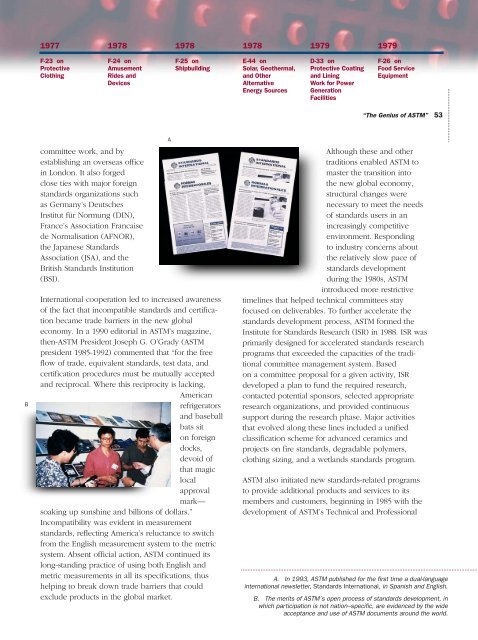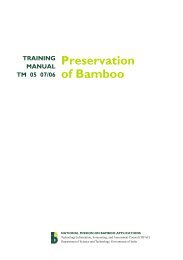ASTM
Create successful ePaper yourself
Turn your PDF publications into a flip-book with our unique Google optimized e-Paper software.
1977<br />
1978<br />
1978<br />
1978<br />
1979<br />
1979<br />
F-23 on<br />
Protective<br />
Clothing<br />
F-24 on<br />
Amusement<br />
Rides and<br />
Devices<br />
F-25 on<br />
Shipbuilding<br />
E-44 on<br />
Solar, Geothermal,<br />
and Other<br />
Alternative<br />
Energy Sources<br />
D-33 on<br />
Protective Coating<br />
and Lining<br />
Work for Power<br />
Generation<br />
Facilities<br />
F-26 on<br />
Food Service<br />
Equipment<br />
“The Genius of <strong>ASTM</strong>” 53<br />
B<br />
committee work, and by<br />
establishing an overseas office<br />
in London. It also forged<br />
close ties with major foreign<br />
standards organizations such<br />
as Germany’s Deutsches<br />
Institut für Normung (DIN),<br />
France’s Association Francaise<br />
de Normalisation (AFNOR),<br />
the Japanese Standards<br />
Association (JSA), and the<br />
British Standards Institution<br />
(BSI).<br />
International cooperation led to increased awareness<br />
of the fact that incompatible standards and certification<br />
became trade barriers in the new global<br />
economy. In a 1990 editorial in <strong>ASTM</strong>’s magazine,<br />
then-<strong>ASTM</strong> President Joseph G. O’Grady (<strong>ASTM</strong><br />
president 1985-1992) commented that “for the free<br />
flow of trade, equivalent standards, test data, and<br />
certification procedures must be mutually accepted<br />
and reciprocal. Where this reciprocity is lacking,<br />
American<br />
refrigerators<br />
and baseball<br />
bats sit<br />
on foreign<br />
docks,<br />
devoid of<br />
that magic<br />
local<br />
approval<br />
mark—<br />
soaking up sunshine and billions of dollars.”<br />
Incompatibility was evident in measurement<br />
standards, reflecting America’s reluctance to switch<br />
from the English measurement system to the metric<br />
system. Absent official action, <strong>ASTM</strong> continued its<br />
long-standing practice of using both English and<br />
metric measurements in all its specifications, thus<br />
helping to break down trade barriers that could<br />
exclude products in the global market.<br />
A<br />
Although these and other<br />
traditions enabled <strong>ASTM</strong> to<br />
master the transition into<br />
the new global economy,<br />
structural changes were<br />
necessary to meet the needs<br />
of standards users in an<br />
increasingly competitive<br />
environment. Responding<br />
to industry concerns about<br />
the relatively slow pace of<br />
standards development<br />
during the 1980s, <strong>ASTM</strong><br />
introduced more restrictive<br />
timelines that helped technical committees stay<br />
focused on deliverables. To further accelerate the<br />
standards development process, <strong>ASTM</strong> formed the<br />
Institute for Standards Research (ISR) in 1988. ISR was<br />
primarily designed for accelerated standards research<br />
programs that exceeded the capacities of the traditional<br />
committee management system. Based<br />
on a committee proposal for a given activity, ISR<br />
developed a plan to fund the required research,<br />
contacted potential sponsors, selected appropriate<br />
research organizations, and provided continuous<br />
support during the research phase. Major activities<br />
that evolved along these lines included a unified<br />
classification scheme for advanced ceramics and<br />
projects on fire standards, degradable polymers,<br />
clothing sizing, and a wetlands standards program.<br />
<strong>ASTM</strong> also initiated new standards-related programs<br />
to provide additional products and services to its<br />
members and customers, beginning in 1985 with the<br />
development of <strong>ASTM</strong>’s Technical and Professional<br />
A. In 1993, <strong>ASTM</strong> published for the first time a dual-language<br />
international newsletter, Standards International, in Spanish and English.<br />
B. The merits of <strong>ASTM</strong>’s open process of standards development, in<br />
which participation is not nation–specific, are evidenced by the wide<br />
acceptance and use of <strong>ASTM</strong> documents around the world.




